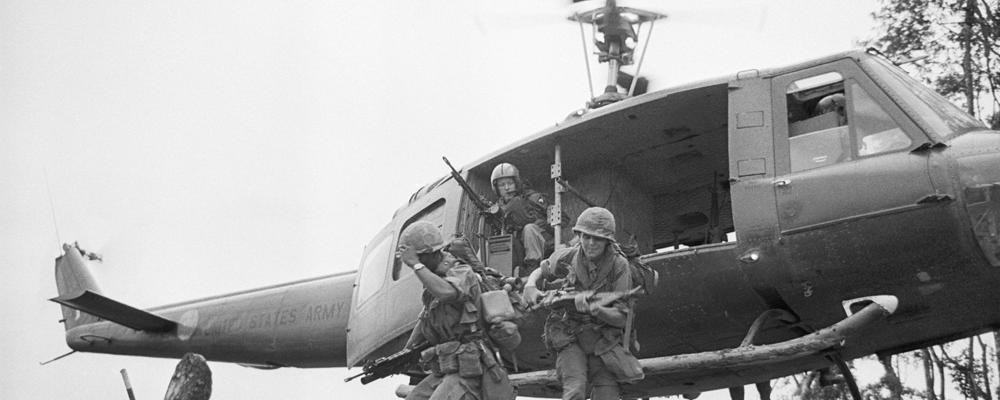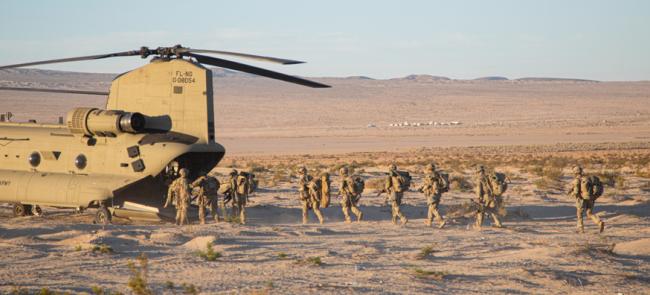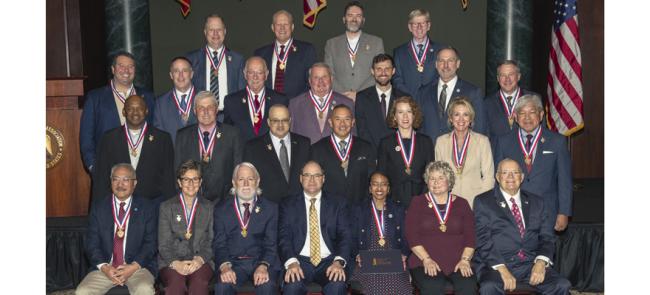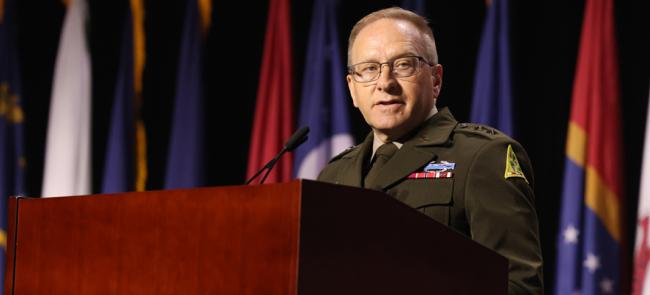
Lessons Learned
Fifty years ago, the United States was beginning to breathe again. That included the National Guard.
Although it couldn’t be fully comprehended at the time, 1973 marked the start of a sea change of relief for a country that had been fighting a lengthy war in Vietnam while fighting over the war and other issues at home. America had not seen such division since the Civil War a century earlier.
But there was indeed light at the end of the tunnel. The Paris Peace Accords officially ended U.S. combat operations in then-North and South Vietnam on Jan. 27, 1973, and the All-Volunteer Force began shortly thereafter. The draft, which was the source of so much contention, was over.
Then came Total Force Policy, which was adopted that August. It declared that the services would integrate their active and reserve forces “into a homogeneous whole” for resourcing and planning. Unlike what had occurred in Vietnam, the United States would never again go to war without significant Guard and Reserve participation.
The Guard did see action in Southeast Asia, but in small numbers and only later in the conflict. After playing a major role in every previous U.S. conflict, the Guard was initially left on the sidelines. President Lyndon Johnson thought sending Guard units to Vietnam would damage the war’s support in the small towns most likely to back the effort. Instead, he leaned on draftees.
The plan proved misguided, according to Michael D. Doubler, a former Guardsman, historian and author of I Am the Guard. Relying on conscripts, he says, “planted the seeds” of what became an effective resistance that helped turn public opinion against the war, which the United States entered to stem communism’s march across Southeast Asia.
Johnson relented in 1968 following two unexpected events — North Korea capturing the Navy surveillance ship USS Pueblo and the Tet Offensive. The Pentagon mobilized several Army and Air Guard units.
Roughly 9,000 Army Guard soldiers served in Vietnam in eight units or as individual volunteers or replacements. The units (see at bottom) included field artillery battalions from Kentucky and New Hampshire, an engineer battalion from Idaho and a Ranger company from Indiana. Other mobilized units sent individual replacements.
Four Air Guard F-100 tactical fighter squadrons also got into the fight and were credited with 24,124 combat sorties. Other Air Guard units went to South Korea to bolster the force there. The Air Guard played an even longer and larger support role — airlifting supplies during more than 1,000 missions to Vietnam, flying wounded troops back to the States and taking on the Air Force’s refueling missions in Europe.
And, in 1968 alone, 105,000 Army and Air Guardsmen were called to local authorities deal with 77 civil disturbances in 29 states and the District of Columbia. Some were violent protests against the war and the draft. There were also riots in several cities as race relations bubbled over. The assassination of the Rev. Martin Luther King Jr. further inflamed the situation.
The Vietnam War was not the Guard’s finest hour any more than it was for the entire U.S. military. Strife home forced the Guard into a visible law enforcement role for which it wasn’t prepared. And Johnson’s reluctance to use the Guard in Vietnam dimmed the force’s reputation as a fighting force.
“Many Army career officers and most of the civilian population thought the Guard made the choice not to go to Vietnam.,” says retired Lt. Gen. H Steven Blum, who began his military career in the Guard in 1968. “Nothing could be further from the truth.”
Joining the Guard or the Reserves “were options that were legitimately available to basically serve the nation and still have some certainty in their lives as to where they would be and what they would do and allow them to balance their civilian lives with the needs of the nation at the time,” Blum insists.
The Guard’s image took another hit in May 1970, when Ohio Army Guard troops opened fire on antiwar protesters at Kent State University. Four students were killed and another nine wounded.
It took many years—and deployments for conflicts in Southwest Asia, peacekeeping missions in the Balkans and homeland security missions at home, especially after 9/11—to change those perceptions.
Many Army career officers and most of the civilian population thought the Guard made the choice not to go to Vietnam. Nothing could be further from the truth.
—Lt. Gen. H Steven Blum (Ret.), a former chief of the National Guard Bureau, began his Guard career in 1968
AS ROUGH AS THINGS WERE during the conflict, Vietnam’s lessons did the Guard some good. People who experienced the war in various ways and remained in the Guard for many years after it was over applied those lessons as they advanced into leadership roles in the decades that followed.
The war helped to unify the force by bringing together active-duty veterans who had gone to war and people who might never have put on a uniform had they not joined to avoid the draft. By many accounts, they got along quite well.
“I joined a unit that was about 40% combat veterans of Korea and Vietnam and about 60% traditional Guardsmen who were not prior service,” explains Blum who, at 22, enlisted in the Maryland Army Guard’s Company B, 19th Special Forces Group (Airborne) — prepared to go to Vietnam.
“There was a deep appreciation and mutual respect between those two groups that was magic,” recalls Blum, who was NGB chief from 2003 to 2008. “It produced a unique, extraordinarily capable unit that, early in my career, told me that the National Guard was every bit as good as any active-duty unit and in many mission sets even better because of civilian-acquired skills.”
Meanwhile, Kent State reinforced the belief that Guard troops should never employ deadly force against other Americans, that quelling civil disturbances at home required leadership, training discipline, protective gear and nonlethal weapons.
Guard leaders were already moving in that direction. Some states had committed to spending more than $500,000 to equip Guardsmen with nonlethal hardware, reported the August 1968 issue of The National Guardsman, as this publication was known at the time. At least 10 states provided troops with floodlights, bullhorns, pry-bars, riot batons, speaker-equipped gasmasks, CS gas dispensers and front-mounted “birdcages” for Jeeps to protect troops from hurled objects.
And NGB mandated that all Guardsmen undergo at least 16 hours of civil disturbance training every year.
The war also brought some very good people into the Guard who learned to love it. Blum says he knows people who joined the Guard to avoid the draft, intending to serve their six years and leave. “But once they were in, they learned to actually treasure and value the lifestyle, the discipline, the values, the training, the camaraderie, the sense of satisfaction for performance of the mission,” he says.
“And many of them stayed in for 10, 20 or 30 years. And if they stayed in long enough and the country actually called upon them, many of these people wound up serving in Iraq and Afghanistan, the Balkans and other places around the world — as well as multiple callouts by their governors for floods, hurricanes, wildfires and other domestic emergencies. They had no idea when they joined that they would ever stay in long enough to experience any of that.”
The war gained Guardsmen a new level of respect from people who were on active duty before coming into the force. Many of them previously believed the Guard to be essentially a hiding place for draft dodgers and the “raggedy-ass militia.”
That was retired Maj. Gen. Philip Killey’s impression as a young active Air Force fighter pilot who flew 129 F-4 missions, including 100 over North Vietnam, from May 1967 to February 1968. He learned differently upon joining the South Dakota Air Guard’s 114th Tactical Fighter Group in 1970.
“I found out that this was not a flying club, that the foundation of the Guard is that traditional Guard person, that part-time fighter pilot who flies for the airlines,” Killey recalls. “They were superb pilots. The maintainers and support people knew their jobs inside and out. The crew chiefs could take apart their airplanes and put them back together without a checklist.”
Air Guard fliers garnered that same respect in Vietnam beginning in April 1968, quickly making friends out of active-duty skeptics who initially wondered how much good those civilians could really do, reported The National Guardsman that September.
“They came in with such a helluva fine attitude it didn’t take us long to really admire this bunch,” Air Force Lt. Col. Tom Knoles marveled about Colorado’s 120th TFS. “They proved their capability and combat-readiness faster than any other outfit I’ve ever seen. They have more experience than I could ever have imagined.”
I look at Vietnam as how not to fight a war.
—Maj. Gen. Philip Killey (Ret.), a former director of the Air National Guard, joined the South Dakota Air Guard after flying combat missions in Vietnam
RETIRED MAJ. GEN. RAYMOND “FRED” REES, a West Point graduate, recalls being impressed with Guard replacements he received while he was a cavalry troop commander with the 101st Airborne Division in South Vietnam in 1969.
“I had an officer and a junior NCO who had been called up with the 29th Brigade out of Hawaii and had come in as individual fillers,” says Rees, who later joined the Guard and served as adjutant general of Oregon, Army Guard director (1991-1992) and several other senior positions at NGB.
“What I found out was these people were very competent,” he says. “They were more mature than most of the other people who were in my organization. They knew their stuff and they did a great job and they had a great attitude.”
It worked the other way as well.
Retired Lt. Gen. Roger Schultz was an Iowa Army Guard lieutenant who had earned his commission from the Iowa Military Academy before going to South Vietnam as an individual replacement in 1969. He commanded a mechanized rifle platoon and then a recon platoon in the 2nd Battalion, 22nd Infantry Regiment. As many as 80% of his troops were draftees, he told famed war correspondent and author Joe Galloway in 2016.
“Those soldiers could have cared less where I had gotten my commission, where I grew up … What they wanted was a lieutenant,” said Schultz, who came home and rose through the ranks to become Army Guard director from 1998 to 2005. “Part of that is everybody’s lives depended on one another. So, you developed a certain kind of reliance on your fellow soldier. When you arrive in a unit by yourself, you become part of the team pretty quickly in a combat outfit.”
Schultz proved himself to be a good leader during his nine and a half months of nearly continuous combat. He earned a Silver Star and recovered from the wounds that resulted in two Purple Hearts during actions that he does not talk very much about. He prefers to focus on the men he led.
And he wrestled with the same fundamental question asked by his troops and many other Americans: Why were they there? “And I have to say, on any day, I probably never did have a good answer for those soldiers,” Schultz told Galloway.
Most importantly, Vietnam taught lessons to a generation of service members who never forgot them as they held senior leadership positions for some three decades beginning around 1977 when retired Lt. Gen. John Conaway became the Air Guard’s deputy director.
Conaway was a Kentucky Guard pilot when he went to South Korea in 1968 and played cat and mouse with North Korean MiG fighters while flying daily reconnaissance missions along the 38th Parallel. The North Koreans’ intent was to draw the Americans across the border between the two Koreas and shoot them down, he says.
“I went to NGB to be deputy director when the Total Force concept was still sinking in,” says Conaway, who served as Air Guard director from 1981 to 1988, and as NGB chief from 1990 to 1993. “We were already fairly integrated, but we got new equipment and got it inspected, and we got held to a higher standard. Total Force did mean we were going the next time.”
“I look at Vietnam as how not to fight a war,” says Killey, who became South Dakota’s adjutant general before serving as Air Guard director from 1988 to 1994. “Our leadership from the president to the secretary of defense claimed the reason we fought that war was to prevent communism from expanding throughout Southeast Asia. But our leadership was afraid of escalation. That’s probably one of the primary reasons they didn’t call up the Guard and the Reserves in significant numbers.”
It was an entirely different situation during the 1990-91 Persian Gulf War, Killey notes. “President [George] H.W. Bush let the military run the war. All the military leadership at the time took the lessons learned from Vietnam and applied them to how to fight the war properly.”
That included calling up the Guard and Reserves some 17 years after the draft had ended, in keeping with the Total Force Policy advocated by Gen. Creighton Abrams, who had commanded American forces in Vietnam from 1968 to 1972.
“I would say the biggest lesson the nation learned from Vietnam, vis a vis the National Guard, is that when you call out the Guard you call out America,” Blum says.
“General Abrams said this nation should never go to war again without a substantial contribution being performed by the National Guard,” he adds. “That brings the fabric of America in every community all across our country into the fight, and if you bring America to the fight, you’ll never lose.”
It means absolutely nothing if the military and the political interests are not in sync.
—Lt. Gen. Roger Schultz (Ret.), a former director of the Army National Guard, served in Vietnam as a replacement
THE HUMAN DIMENSION OF WAR remains an enduring lesson for Schultz.
“When you get down close and personal, this is serious,” he told Galloway. “When you think about 58,000-plus names on that [Vietnam Memorial] Wall, plus how many others that are affected forever, whose names will not be on that Wall; and how many are still missing in action, that is staggering to me.
“A lot of people don’t understand the leadership in the military, that the last thing we want to do is go to war. [But] you better be ready,” Schultz said. “And the be ready side is the cost. It ought to be taken very, very seriously on the part of our nation.”
Everybody must be all in, he said. Families have to be prepared “for the reality of what they might have around the corner. And it’s hard.”
The public should welcome home soldiers and respect them for their service. Medical professionals must be ready to care for those whose wounds, such as post-traumatic stress, are not visible. And the troops need political backing, Schultz explained.
The 1973 Paris Peace Accords enabled America’s withdrawal from Vietnam. Yet, by the time the last American combat troops left the country on March 29, 1973, fighting had already resumed. The war finally ended two years later when North Vietnamese tanks rolled into Saigon, the capital of South Vietnam.
Formal unification of North and South Vietnam occurred in 1976, but the country quickly found itself in political and economic turmoil. Among its first actions was to eliminate the remnants of the old regime in South Vietnam. This led to a lengthy period of political repression. Tens of thousands people fled by boat. The U.N. High Commission for Refugees estimates as many as 400,000 died at sea.
Vietnam also had problems with its neighbors. Its invasion and occupation of Cambodia in 1978 ended the rule of the Chinese-backed Khmer Rouge. In response, China invaded Vietnam in 1979, triggering a brief conflict between the two communist nations.
Meanwhile, the U.S. government believed that Vietnam had violated the peace agreement and had not fulfilled its obligation to account for American prisoners of war. As a result, the United States imposed a trade embargo on Vietnam.
After realizing they needed to find ways to integrate their country into the global economy, Vietnam’s rulers took steps to improve relations with the United States, including allowing the search for U.S. troops missing in action and signing a bilateral trade agreement. These efforts paved the way for the eventual normalization of diplomatic relations in 1995.
Trade and mutual interests in regional security have brought the nations remarkably close in the years since. And the Guard helped. In 2012, the Oregon Guard led by Rees, who had lost troops during the war, established a relationship with Vietnam through the Guard’s State Partnership Program.
Rees says he learned over the years that “if Vietnam was important as a deterrent to communism, it’s also a deterrent to the expansion of Communist China. I realized that Vietnam is a key part of that strategy and that the United States had opportunities to capitalize on this very strong, nationalistic perspective of the Vietnamese.
“So, it didn’t take a lot of urging for me to understand that this would be a great benefit to the Guard, a great benefit to Oregon and a great benefit to the nation if we in fact engage in a state partnership over there,” Rees explains. “I think the State Partnership Program has been very, very instrumental in helping to open the door and especially get dialog going in Vietnam.”
In May, Gen. Daniel R. Hokanson, the NGB chief, visited Vietnam to help reinforce the 11-year SPP relationship. A Guard Bureau story on the visit noted the population of Vietnam has the world’s highest approval rating of Americans at 84%, according to the Pew Research Center.
In early September, President Joe Biden secured business relations and partnerships with Vietnamese officials who accorded their nation’s highest diplomatic status to the United States.
“We can trace a 50-year arc of progress between our nations, from conflict to normalization, to this new elevated status,” Biden said while in Hanoi, Vietnam’s capital, where many American POWs were held during the war.
Bob Haskell is a retired Maine Army National Guard master sergeant and a freelance journalist in Falmouth, Massachusetts. He may be contacted via [email protected].
NATIONAL GUARD UNITS WITH VIETNAM SERVICE
Army National Guard
(Unit/State/Deployed)
650th Medical Detachment
Alabama (August 1968)
116th Engineer Battalion
Idaho (September 1968)
126th Supply & Support Company
Illinois (September 1968)
Company D, 151st Infantry (Ranger)
Indiana (December 1968)
2nd Battalion, 138th Field Artillery
Kentucky (October 1968)
3rd Battalion, 197th Field Artillery
New Hampshire (September 1968)
107th Signal Company
Rhode Island (October 1968)
131st Engineer Company
Vermont (September 1968)
Air National Guard
(Unit/State/Deployed)
120th Tactical Fighter Squadron
Colorado (April 1968)
174th Tactical Fighter Squadron
Iowa (May 1968)
188th Tactical Fighter Squadron
New Mexico (May 1968)
136th Tactical Fighter Squadron
New York (June 1968)
119th Tactical Fighter Squadron*
New Jersey
121st Tactical Fighter Squadron*
District of Columbia
*Neither squadron technically deployed to Vietnam; however, both provided so many volunteers to the active-component’s 355th Tactical Fighter Wing that it was referred to as the “fifth Air Guard squadron” in Vietnam.
Source: National Guard Bureau



